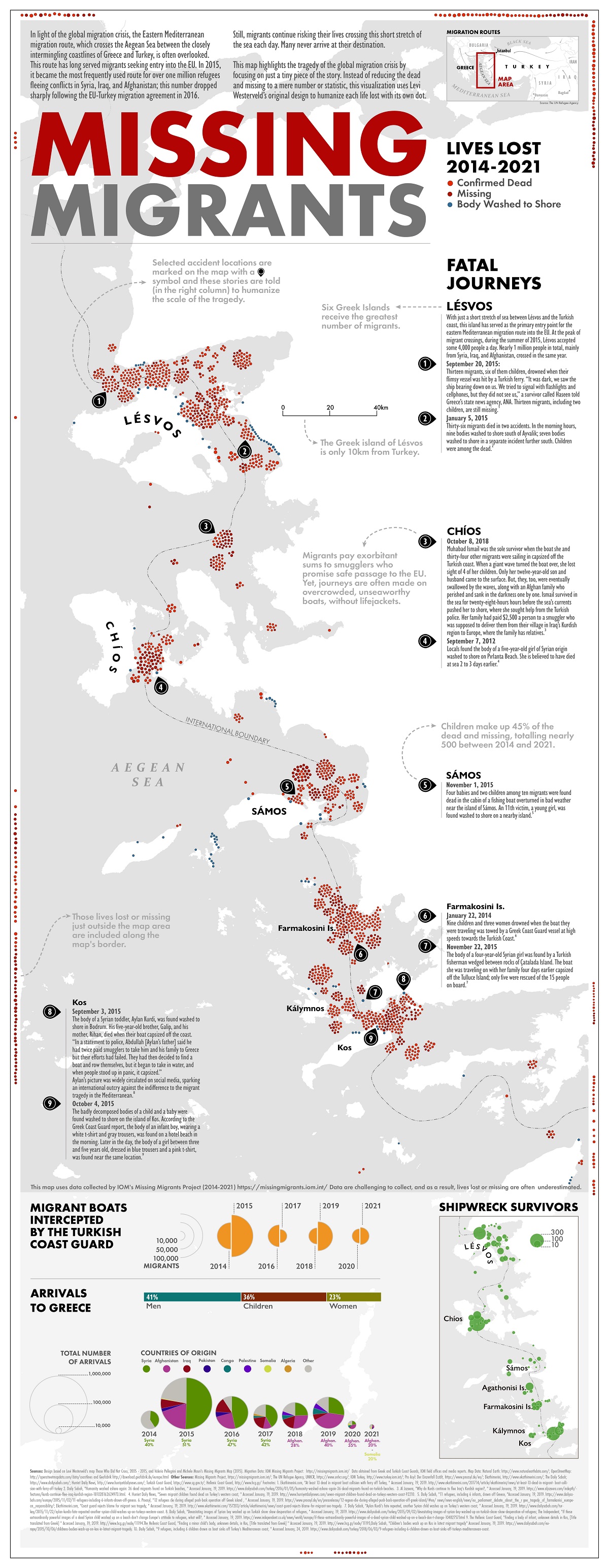
Missing Migrants: Lost Lives Along the Mediterranean Sea
Each year, thousands of migrants flee war-torn countries in search of asylum.
Even before the migrant crisis caused by the Russo-Ukrainian War, Europe has been the focal point in the past decade. Many refugees from conflicts in Africa and Asia, including those from Syria, Afghanistan, and Iraq, and have traveled to Europe along the Eastern Mediterranean migration route—a dangerous passage across the Aegean Sea that weaves along the coastlines of Greece and Turkey.
The journey to reach Europe is risky, and some of the migrants who attempt the crossing never make it. Using data from the International Organization for Migration (IOM), this map by Elbie Bentley visualizes the reported deaths and disappearances along the Eastern Mediterranean from 2014 to 2021.
Inspired by Levi Westerveld’s Those Who Did Not Cross, each lost life is captured with its own dot, in an effort to humanize the data.
The 2015 European Crisis
1,863 deaths and disappearances were reported along the Eastern Mediterranean between the years of 2014 and 2021.
Almost half of those recordings came from 2015 during the European migrant crisis, when a record-breaking one million people sought asylum in the EU.
About 800,000 of the one million migrants traveled to Greece through Turkey, with many of the refugees escaping Syria’s civil war.
| European Migrant Crisis by Year | Reported deaths and disappearances |
|---|---|
| 2014 | 101 |
| 2015 | 804 |
| 2016 | 434 |
| 2017 | 62 |
| 2018 | 174 |
| 2019 | 71 |
| 2020 | 106 |
| 2021 | 111 |
In an attempt to control the situation, the EU and Turkey signed a migration deal in March 2016 that agreed to send back migrants who did not receive official permission to enter the EU.
Though the agreement drastically reduced the number of people traveling through Turkey to Greece, thousands still make the dangerous journey across the Aegean Sea each year. In 2021, 111 people were reported dead or missing along the Eastern Mediterranean.
The Dangerous Journey
According to the International Organization for Migration, the most common cause of death along the Eastern Mediterranean is drowning.
While the journey is only 5.4 nautical miles or less, transportation conditions to Greece are not always safe. Boats are sometimes forced into tumultuous waters, according to migrants who’ve experienced the journey firsthand.
And these boats are often severely underequipped and overcrowded—rubber dinghies designed to carry a dozen people are sometimes loaded with up to 60 passengers.
Safer means of transportation are available, but the costs are steep. According to Frontex, the European Border and Coast Guard Agency, it could cost a family an average of €10,000 to travel by yacht.
Rescue Efforts for Migrants is Needed
Further complicating the dangerous journey is a lack of rescue resources.
According to a 2021 report by IOM, the EU does not currently have a dedicated search and rescue team. Instead, the onus is on individual states to patrol their own waters.
Until the crisis is better addressed or local conflicts begin to resolve, there will be an urgent need for increased rescue operations and a standardized migration protocol to help mitigate the number of migrant deaths and disappearances each year.
The post Missing Migrants: Visualizing Lost Lives Along the Mediterranean Sea appeared first on Visual Capitalist.